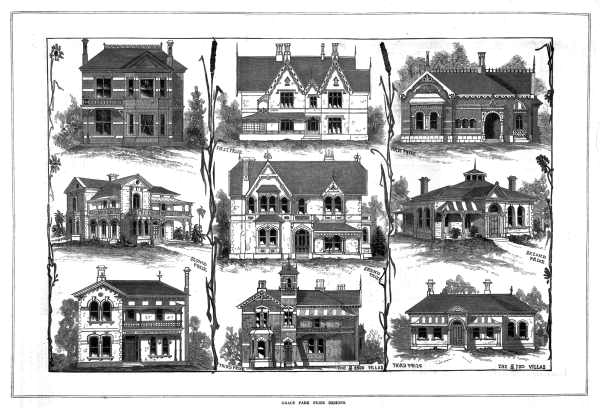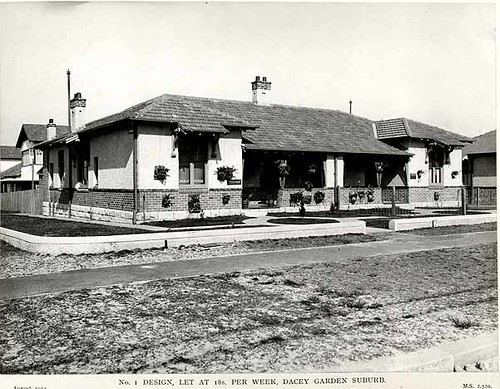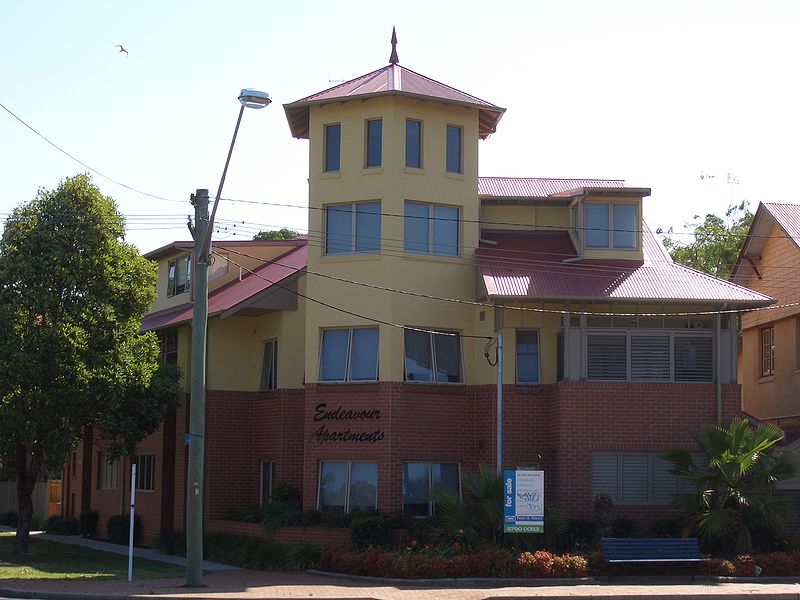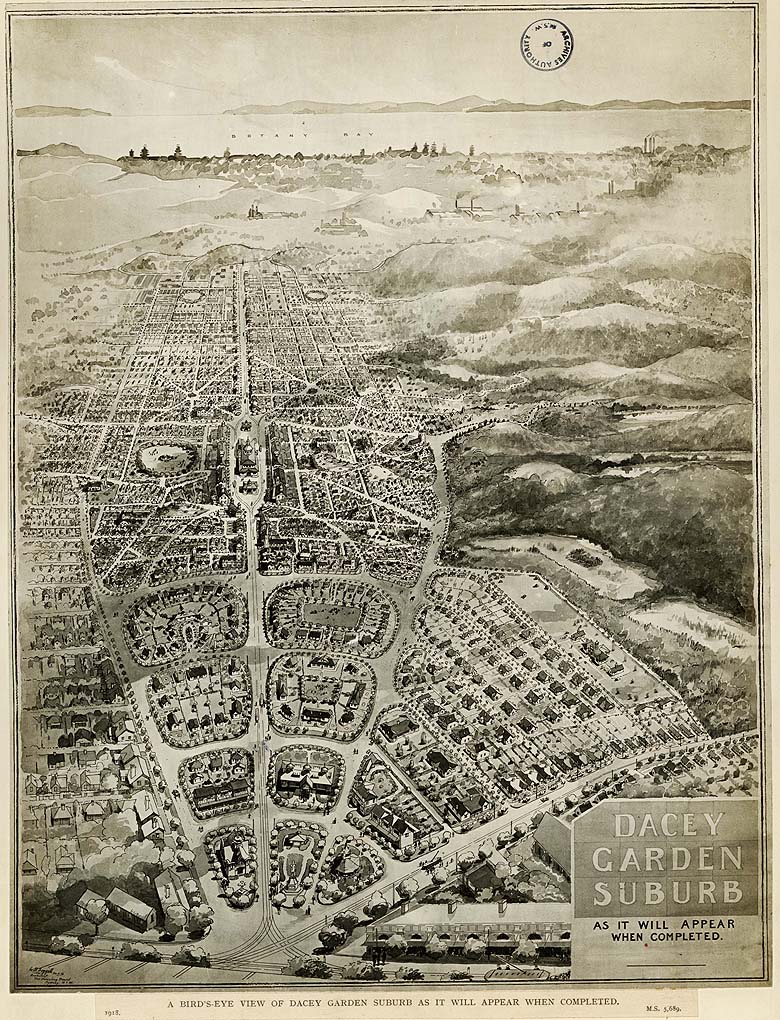Architects of Federation Housing in Australia
[Previous page: Australiana decoration in Federation houses Next page:]Melbourne Architects
From the Dictionary of Melbourne, Architecture"Younger (Melbourne) architects shared (an) interest in changeful, often asymmetrical forms and empathy.
 |
| Grace Park Estate, Hawthorn |
But they focused on the emerging British and American arts and crafts 'Free Style' architectures, variously and inappropriately dubbed 'Queen Anne' or 'American Romanesque'. These...
- expressed materials and interior circumstance more directly,
- had freer internal plans and
- accentuated structure and links to local climate, nature and even perceived social patterns.
"This shift was informed by national sentiment, and led to a new fusion, Federation architecture, evident in
- more centralised plans where possible,
- plain brick or timber exteriors,
- complex roofs drawing wings and porches together under a hipped, tiled homestead form.
 |
| Warwillah |
Image ©2011 Walking Melbourne
Warwillah - a Transitional Modern Gothic/Queen Anne design with an asymmetrical facade.
It has a prominent gable with pointed arches and colonettes and a great stained glass window.
From around 1887 Melbourne leaders were Alfred Dunn in Hawthorn and Toorak, Christopher Cowper in Hawthorn and Camberwell (Grace Park, Broadway), Arthur Fisher in St Kilda, A.B. Rieusset in Caulfield, Henry Kemp and Beverley Ussher in Essendon, Kew and Canterbury.
After 1900 **Harold Desbrowe-Annear**, Robert Haddon, Nahum Barnet, Walter Butler, Rodney Alsop and others moved to new levels of open planning, new materials and Art Nouveau balances of line and plane, while maintaining formal origins in Federation architecture.
- Haddon's Fourth Victoria Building alterations of 1912 and Swinburne College Art School of 1917 epitomise the new simplicity of form, echoed in contemporary Smith Ogg & Serpell designs, probably also involving Haddon:
- Milton House (1900-02),
- Eastbourne Terrace (1901), and
- The Kilkenny Inn, Lonsdale Street (1915).
The following illustrations and citations are from "Walking Melbourne"
Mitre Tavern 1900Built: 1900 - 1910
Mitre Tavern
Image ©2011 Walking Melbourne
Majella Mansion
Majella Mansion
Built: 1913
Large Edwardian mansion with cruved features and prominent gables.
Image ©2011 Walking Melbourne
Avalon Mansion
Avalon
Built: 1903
This large mansion reads as a an Edwardian terrace from its southern side with a long timbered verandah divided into ornate bays and sections with a pavillionstyled roofline.
Image ©2011 Walking Melbourne
St. Hilda's House
St Hildas House
Built: 1907
Image ©2011 Walking Melbourne
These featured houses are from the "Review of B-grade Buildings in Kew, Camberwell & Hawthorn" which is prepared by the city of Boroondara as a contribution to the development of Federation (architecture).
 |
| Camberwell residence designed by architect N P Anderson |
The Bungalow, (became) the major suburban mode of (domestic housing) around 1915-26.
Federation form was simplified to basically four-square 'servantless houses'.
Canterbury home of architect C H Richardson
- Open corners or porches replaced return verandahs, and a new horizontality and Japanese detailing stemmed from an influential US Bungalow movement.
- Witness Oakden & Ballantyne's Martin house, Malvern (1908).
 |
| Balwyn bungalow possibly designed by Graeme Butler |
Melbourne Bungalows differed from their generally more solid and densely packed Sydney counterparts, had a heavier grain than Brisbane stump-house Bungalows and were tighter - visually and physically - than spreading Adelaide Bungalows.
- Contained and sheltering, they fitted Australia's inward-turning 1920s mood and were usefully cheap in that uneven economy.
- Bungalows proliferated in subdivisions of ostensibly older suburbs like Richmond, Brunswick and Northcote,
- and dominated bayside housing from St Kilda to Portsea.
Leading architects included Marcus Barlow, the Tompkins brothers, G.B. Leith and the State Savings Bank office.
Designer-builder real estate firms, from Dunlop & Cornwell in Murrumbeena to Algernon Elmore in Blackburn, extended packaged design and financing that marks housing construction to this day.
- The Bungalow could stretch to churches (Mount Pleasant Uniting, Nunawading, 1917; Church of Christ, Balwyn, 1926),
- railway stations (Mentone, Hampton),
- and even walk-up flats - 'Manhattan bungalows' - in Prahran and South Yarra.
- They were not simply one-storeyed: 'Bungalow' meant informal, healthy living and shelter at day's end, resonant notions after the Great War and its influenza pandemic.
Bungalow form was moderated by other, conspicuously applied styles later in the 1920s and the early to mid-1930s. These included
- suburban Tudor and French Provincial modes, and
- Spanish Mission gained lustre from Hollywood, a new metropolis for Australia's imagination.
Subdivisions in the 1920s and 1930s such as the Golf Links and Hassett estates in Camberwell and fringe suburbs - East Malvern, Ashburton and Ivanhoe - all reflected this shift.

















 Built in 1912-1915, Babworth House is a grand Federation Arts and Crafts-style mansion that was adapted to apartments eight years ago. Built 1912-1915; Renovated 2002; Situated at 1 Mount Adelaide Street, Darling Point, Sydney, NSW.
Built in 1912-1915, Babworth House is a grand Federation Arts and Crafts-style mansion that was adapted to apartments eight years ago. Built 1912-1915; Renovated 2002; Situated at 1 Mount Adelaide Street, Darling Point, Sydney, NSW.























